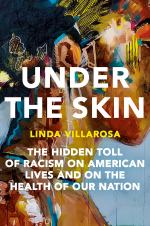|
This section contains 719 words (approx. 2 pages at 400 words per page) |

|
Under the Skin: The Hidden Toll of Racism on American Lives and on the Health of Our Nation Summary & Study Guide Description
Under the Skin: The Hidden Toll of Racism on American Lives and on the Health of Our Nation Summary & Study Guide includes comprehensive information and analysis to help you understand the book. This study guide contains the following sections:
This detailed literature summary also contains Topics for Discussion on Under the Skin: The Hidden Toll of Racism on American Lives and on the Health of Our Nation by Linda Villarosa.
The following version of this book was used to create the guide: Villarosa, Linda. Under the Skin: The Hidden Toll of Racism on American Lives and the Health of Our Nation. Penguin Random House LLC., 2022.
Linda Villarosa's Under the Skin: The Hidden Toll of Racism on American Lives and the Health of Our Nation is a work of nonfiction. A seasoned writer and journalist, Villarosa examines the effects of institutionalized racism via a series of human-interest stories. Villarosa presents the detailed accounts of her research subjects' lives. These narratives ground and reify Villarosa's overarching, political commentaries and social criticisms. The following summary follows the text's overarching structure, but offers a more streamlined mode of explanation.
In Chapter 1, "Everything I Thought Was Wrong," for years, Villarosa wrote for Essence magazine. Her contributions to the publication particularly focused on the health of Black American women. She primarily touted principles of healthy eating, self-care, and self-love. Over time, however, Villarosa's outlook on the health and health care of Black Americans has evolved. She still stands by her previous philosophies, but a series of investigative projects and personal experiences have made her realize these philosophies were incomplete. Witnessing her father's poor treatment while hospitalized for colon cancer was particularly influential in this regard. Although he was neither impoverished nor uneducated, Villarosa's father was granted neither respect nor dignity. In order to convince his caretakers to give him the help he needed and deserved, Villarosa tried to make them see her father as human.
In Chapter 2, "The Dangerous Myth That Black Bodies Are Different," Villarosa presents the stories of Minnie Lee and Mary Alice Relf. In 1972, when the Relf sisters were just 14 and 12 years old respectively, they were removed from their home and sterilized without their knowledge or their parents' consent. Villarosa examines the story of the sisters' forced sterilization in order to expose the history of abuse and exploitation Blacks have suffered throughout American history.
In Chapter 3, "Unequal Treatment," when Villarosa's friend suggested that she write a piece about maternal and infant mortality, she was skeptical. She did not believe these were issues in the United States. However, after meeting a doula and social justice worker named Latona Giwa, Villarosa's beliefs began to change. Through Giwa, she also met her client, Simone Landrum. Witnessing the abuse Landrum suffered while giving birth alarmed Villarosa and inspired her influential article in The New York Times Magazine.
In Chapter 4, "Something About Being Black Is Bad for Your Body and Your Baby," Villarosa tells the story of Jamaican immigrant Avril Francis and her daughter Heather Miller. Although her mother gave birth to healthy babies, Heather had a different experience during pregnancy and childbirth. The author uses Heather's experience to consider the ways in which racial oppression harms women's health and the health of their babies.
In Chapter 5, "Where You Live Matters," Villarosa centralizes Danielle Bailey's story. After years of living in Walnut Cove, North Carolina, Danielle learned that the neighboring power plant had poisoned her body. When she was only in her thirties, she was diagnosed with brain cancer. The author uses Danielle's story to consider how racial inequality begets poor living circumstances and dangerous health implications for poor, Black Americans.
In Chapter 6, "Strong, Loud, and Angry: The Invisibility of Black Emotional Pain," Villarosa presents the stories of Audrey Brianne, Terrie Williams, and Mark McMullen. All three individuals struggled with mental illness throughout their lives. Instead of seeking help, however, they spent years trying to hide, mask, ignore, or dismiss their emotional experiences. The author uses their stories to consider the ways in which racist stereotypes disregard the mental health of Black Americans.
In Chapter 7, "Discrimination and Ill-Treatment Can Harm Every Body," Villarosa documents her visit to Friendship House in Morgantown, West Virginia. While here, Villarosa realized the ways in which systemic racism has disenfranchised poor individuals struggling with illness and addiction.
In Chapter 8, "Putting the Care Back in Health Care: Solutions," Villarosa argues the importance of community health workers, or CHWs, to the health and wellness of Black Americans. She tries to find hope in CHWs efforts, yet is reluctant to offer false optimism.
In the afterword, Villarosa traces the events of 2020. She argues that the pandemic and the concurrent social justice movement have begun to alter conversations about race and healthcare in America.
Read more from the Study Guide
|
This section contains 719 words (approx. 2 pages at 400 words per page) |

|



